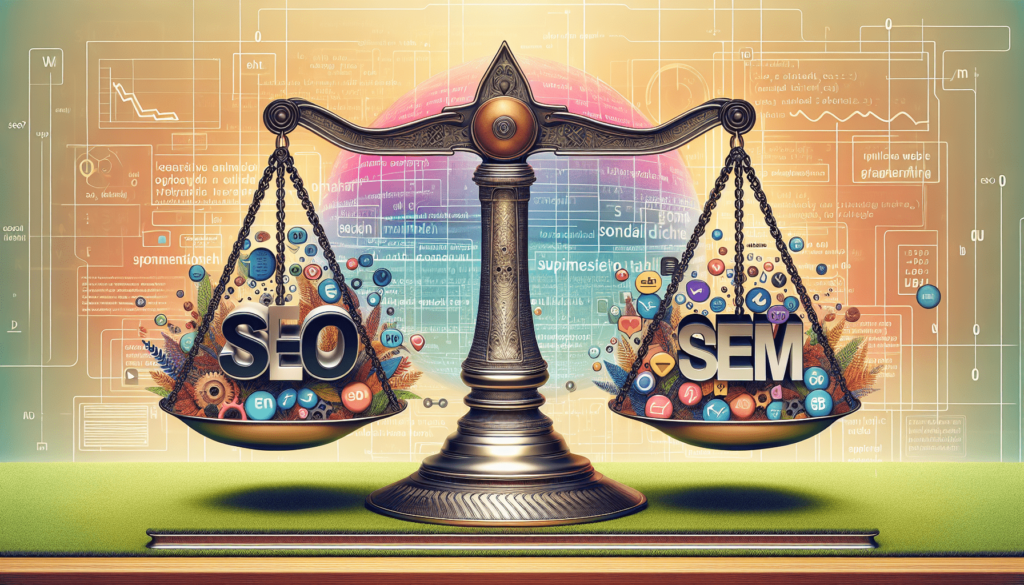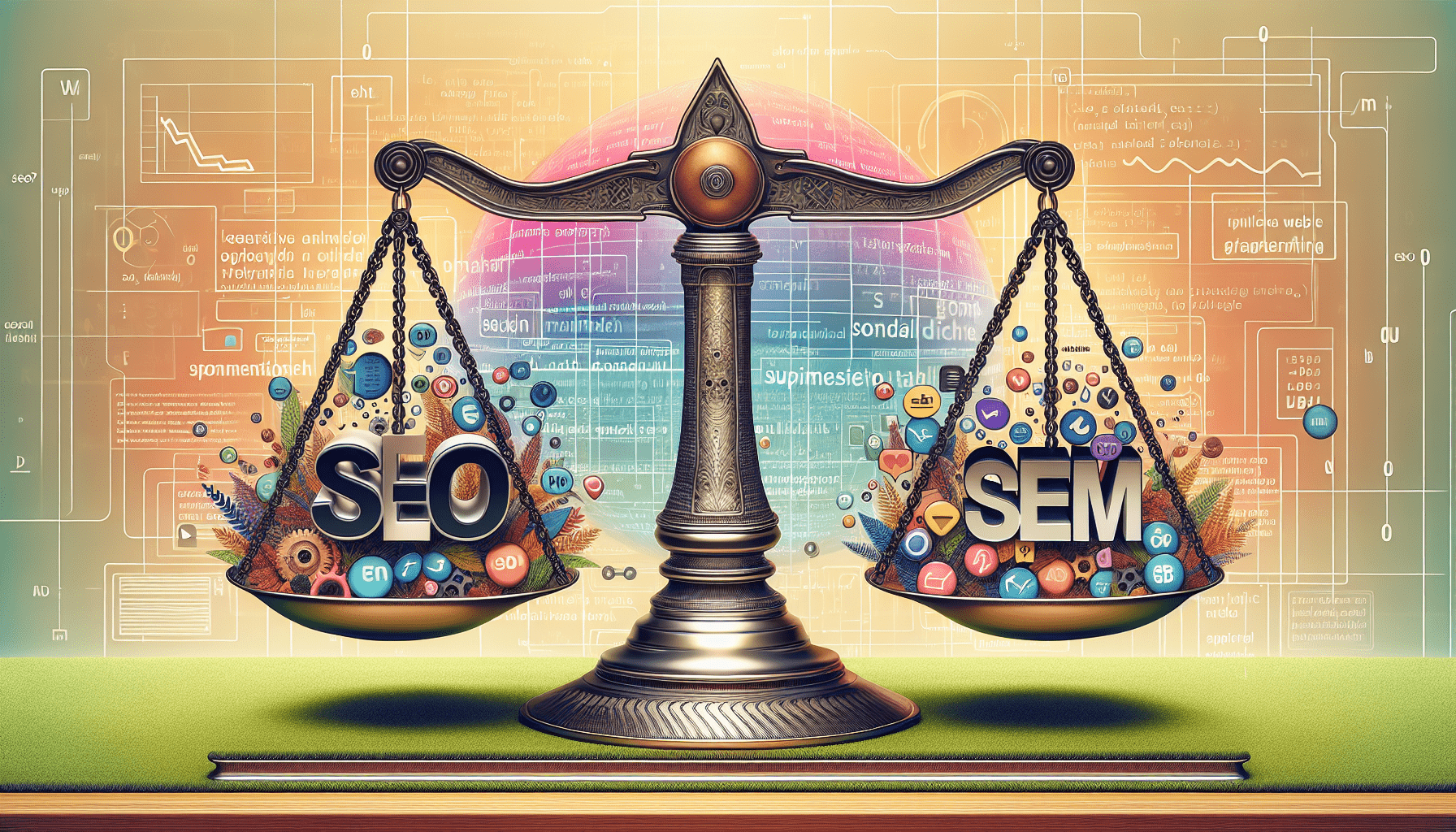In the ever-evolving world of online marketing, it can be quite overwhelming to decide which approach is the key to unlocking success for your business. Today, we will shed some light on the age-old debate of SEO versus SEM. Both strategies have their merits, but it all boils down to understanding the nuances and making the right choice for your specific goals. So, fasten your seatbelt as we take you on a journey to demystify the world of SEO and SEM, and help you make an informed decision that will propel your brand to new heights. Get ready to empower your business with the right strategy!

What is SEO?
SEO stands for Search Engine Optimization. It is the practice of optimizing a website in order to improve its visibility and ranking on search engine results pages (SERPs). The goal of SEO is to increase organic, or unpaid, traffic to a website through various strategies such as improving website structure, creating high-quality content, and optimizing keywords.
What is SEM?
SEM stands for Search Engine Marketing. It is a paid advertising strategy that focuses on increasing a website’s visibility on search engine results pages through paid advertisements. SEM involves bidding on keywords and creating compelling ad campaigns to attract targeted traffic to a website. Google Ads is one of the most popular platforms for SEM.
Differences between SEO and SEM
Definition
The main difference between SEO and SEM lies in the approach and funding. SEO focuses on improving organic search rankings and does not involve paying for ad space. On the other hand, SEM involves paying for advertisements to appear on search engine results pages.
Timing
SEO is a long-term strategy that requires time and patience to see significant results. It takes time for search engines to crawl and index a website’s pages and evaluate its relevance. In contrast, SEM provides immediate results as ads can appear on search results pages as soon as a campaign is set up.
Cost
SEO is a cost-effective strategy as it does not involve paying for ad placements. However, it requires investment in terms of time, resources, and possibly hiring an SEO specialist. SEM, on the other hand, requires a budget for bidding on keywords and running ad campaigns.
Approach
SEO focuses on optimizing website elements, such as content, keywords, metadata, and user experience, to improve organic search rankings. It involves conducting keyword research, creating valuable content, and optimizing website structure. SEM, on the other hand, involves creating compelling ads and bidding on keywords to drive targeted traffic to a website.
Benefits of SEO
Organic Traffic
One of the significant benefits of SEO is the ability to attract organic traffic. When a website ranks high on search engine results pages, it is more likely to receive clicks and visits from users who are actively searching for information or products related to their search query. This targeted organic traffic can result in higher conversion rates and better user engagement.
Long-term Results
SEO is a long-term strategy that continues to deliver results over time. Once a website earns a higher ranking on search engine results pages, it can benefit from increased visibility and ongoing organic traffic. Unlike SEM, where traffic stops when the ad campaign ends, SEO provides sustainable results.
Brand Visibility
SEO plays a crucial role in building brand visibility and credibility. When a website consistently appears on the first page of search results, users are more likely to trust it and consider it as a reputable source of information or products. Improved brand visibility can lead to higher brand awareness, increased website traffic, and better customer loyalty.

Benefits of SEM
Immediate Results
One of the significant advantages of SEM is the ability to achieve immediate results. As soon as an ad campaign is set up and activated, the ads can start appearing on search results pages and driving traffic to the website. This is especially beneficial for businesses that want to generate quick results, such as promoting a time-sensitive sale or event.
Precise Targeting
SEM provides precise targeting options that allow businesses to reach their desired audience effectively. Advertisers can select specific keywords, demographics, geographic locations, and even device preferences to ensure their ads are shown to the most relevant audience. This targeting capability helps in maximizing the return on investment (ROI) and reaching potential customers who are more likely to convert.
Increased Brand Exposure
SEM can significantly increase brand exposure by displaying ads to a wider audience. Even if users do not click on the ads, they are exposed to the brand name, product, or service, which can increase brand awareness and recognition. This increased exposure can have a positive impact on brand credibility and influence customer perception.
When to Use SEO
Established Website
SEO is best suited for established websites that have a solid foundation in terms of content, user experience, and overall website structure. It is an ideal strategy for businesses that are looking for long-term growth in organic search rankings and sustained visibility on search engine results pages.
Long-term Goals
If your business has long-term goals and aims to establish a strong online presence, SEO is the way to go. While it might take time to see significant results, the sustainable growth that comes with SEO can lead to improved organic traffic, higher conversion rates, and increased brand visibility.
Limited Budget
SEO is a cost-effective strategy compared to SEM, as it does not involve paying for ads. If your budget is limited and you are willing to invest in long-term strategies, SEO allows you to drive organic traffic without incurring additional costs for ad placements.
When to Use SEM
New Website
If you have a new website and want to generate immediate traffic, SEM is the recommended strategy. As a new website, it can take time for SEO efforts to yield results. By incorporating SEM, you can start driving targeted traffic to your website while your SEO efforts are still in progress.
Short-term Goals
SEM is particularly beneficial for businesses that have short-term goals or are promoting time-sensitive events, such as limited-time offers or seasonal sales. The immediate results that come with SEM can help achieve these goals within a shorter time frame.
Higher Budget
SEM involves paying for ads, which means it requires a budget for bidding on keywords and running ad campaigns. If you have a higher budget and are looking for ways to drive immediate traffic and achieve quick results, SEM allows you to invest in paid advertising and reach your target audience effectively.
SEO vs. SEM for E-commerce
Product Keywords
For e-commerce businesses, both SEO and SEM are crucial. SEO helps in optimizing product pages, improving website structure, and creating relevant content that targets specific product keywords. SEM, on the other hand, allows businesses to bid on product-related keywords and display ads for specific products, driving targeted traffic to the e-commerce website.
Competitive Landscape
The competitive landscape can also play a role in deciding whether to focus more on SEO or SEM for e-commerce. If the competition for specific product keywords is high, investing in SEM can help ensure that the e-commerce website appears prominently on search results pages, even in the face of strong competition. SEO can complement SEM efforts by improving organic rankings for other relevant keywords and increasing overall visibility.
Conversion Rates
When it comes to conversion rates, both SEO and SEM can have a positive impact. SEO helps in driving organic traffic, which tends to have higher conversion rates as users actively search for specific products or information. SEM, on the other hand, enables businesses to target users who are further down the conversion funnel, as they are actively searching for specific products and are more likely to make a purchase.
Choosing the Right Strategy
Assessing Your Goals
To choose the right strategy, it is essential to assess your goals and consider factors such as short-term vs. long-term objectives, budget constraints, and the competitive landscape. If you aim for sustained growth and have a limited budget, SEO might be the more suitable option. For businesses with short-term goals or higher budgets, SEM can offer immediate results and precise targeting.
Evaluating Your Budget
Your available budget plays a crucial role in deciding between SEO and SEM. SEO is a cost-effective strategy as it does not involve paying for ads, but it does require investment in terms of time and resources. SEM, on the other hand, requires a budget for bidding on keywords and running ad campaigns. Evaluating your budget will help determine which strategy is more feasible for your business.
Understanding Your Audience
Understanding your target audience is vital in deciding between SEO and SEM. If your audience primarily relies on organic search results and prefers in-depth research before making a purchase decision, investing in SEO can help drive organic traffic and engage with your audience. However, if your audience is more likely to click on ads and make immediate purchasing decisions, SEM can help you reach them effectively.
Conclusion
Both SEO and SEM are valuable strategies that can drive traffic and increase visibility for your website. The choice between the two depends on various factors, including your goals, budget, and audience preferences. SEO offers long-term growth and organic traffic, while SEM provides immediate results and precise targeting. Understanding your business requirements and evaluating these factors will help you choose the right strategy that aligns with your goals and maximizes your online presence.

